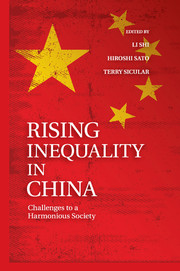Book contents
- Frontmatter
- Contents
- List of Tables
- List of Figures
- Contributors
- Preface
- Abbreviations
- Glossary
- 1 Rising Inequality in China
- 2 Overview
- 3 Housing Ownership, Incomes, and Inequality in China, 2002–2007
- 4 Educational Inequality in China
- 5 Inequality and Poverty in Rural China
- 6 The Evolution of the Migrant Labor Market in China, 2002–2007
- 7 A New Episode of Increased Urban Income Inequality in China
- 8 Unemployment and the Rising Number of Nonworkers in Urban China
- 9 Do Employees in the Public Sector Still Enjoy Earnings Advantages?
- 10 Redistributive Impacts of the Personal Income Tax in Urban China
- 11 Changes in the Gender-Wage Gap in Urban China, 1995–2007
- 12 Intertemporal Changes in Ethnic Urban Earnings Disparities in China
- Appendix I The 2007 Household Surveys
- Appendix II The 2002 and 2007 CHIP Surveys
- Index
- References
7 - A New Episode of Increased Urban Income Inequality in China
Published online by Cambridge University Press: 05 July 2013
- Frontmatter
- Contents
- List of Tables
- List of Figures
- Contributors
- Preface
- Abbreviations
- Glossary
- 1 Rising Inequality in China
- 2 Overview
- 3 Housing Ownership, Incomes, and Inequality in China, 2002–2007
- 4 Educational Inequality in China
- 5 Inequality and Poverty in Rural China
- 6 The Evolution of the Migrant Labor Market in China, 2002–2007
- 7 A New Episode of Increased Urban Income Inequality in China
- 8 Unemployment and the Rising Number of Nonworkers in Urban China
- 9 Do Employees in the Public Sector Still Enjoy Earnings Advantages?
- 10 Redistributive Impacts of the Personal Income Tax in Urban China
- 11 Changes in the Gender-Wage Gap in Urban China, 1995–2007
- 12 Intertemporal Changes in Ethnic Urban Earnings Disparities in China
- Appendix I The 2007 Household Surveys
- Appendix II The 2002 and 2007 CHIP Surveys
- Index
- References
Summary
Introduction
The development of income inequality in urban China is a hot topic. There is agreement that income inequality has tended to increase over the years, but evidence indicates that the development has not been smooth. For example, previous studies based on the China Household Income Project (CHIP) have found that earnings inequality at the individual level as well as income inequality at the household level in urban China increased profoundly from 1988 to 1995. However, although from 1995 to 2002 earnings inequality continued to increase, income inequality at the household level decreased modestly (Gustafsson, Li, and Sicular 2008). Rapid growth in incomes caused urban poverty, assessed by a poverty line representing constant purchasing power (“absolute poverty”), to diminish rather substantially (Appleton, Song, and Xia 2010). What has happened more recently, during the initial phase of the Hu Jintao–Wen Jiabao leadership (2002–2007)? In this chapter we aim to shed new light on developments during this period using data from the CHIP urban household survey.
Our first research question is, How did income, income inequality, and poverty develop? To answer this question, we show income growth curves and report estimates of income inequality. Furthermore, we show cumulative density functions and report summary measures on absolute and relative poverty for 1988, 1995, 2002, and 2007. The second research question is, What were the forces for change during the period from 2002 to 2007? To understand this, we decompose the Gini coefficient of disposable household per capita income by income components for 2002 and 2007. The third research question is, How have various categories of the population fared during the period from 2002 to 2007? To answer this question we look at differences among groups based on ownership, sector, age, and education.
- Type
- Chapter
- Information
- Rising Inequality in ChinaChallenges to a Harmonious Society, pp. 255 - 288Publisher: Cambridge University PressPrint publication year: 2013



